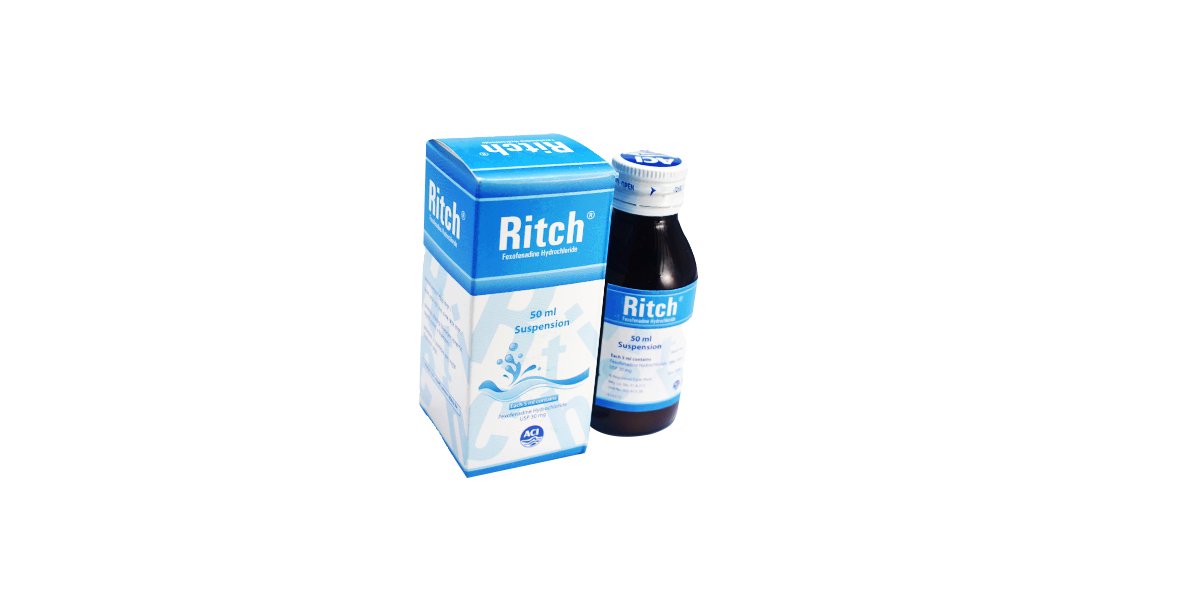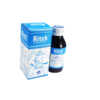Description
Ritch® Fexofenadine Hydrochloride Description Ritch® is a preparation of Fexofenadine Hydrochloride, the synthetic Hydrochloride salt of Fexofenadine which is the Carboxylic Acid metabolite of Terfenadine. Fexofenadine is an orally active non-sedating H1 receptor antagonist and is effective for the relief of symptoms associated with allergic rhinitis and urticaria. Fexofenadine is rapidly absorbed after oral administration with peak plasma concentration being reached in 2 to 3 hours. Fexofenadine is metabolized mostly by intestinal mucosa and only few undergo hepatic biotransformation. Fexofenadine is excreted mainly in the faeces with only 10% being present in the urine. Fexofenadine does not appear to cross the blood brain barrier. Indications and Uses Ritch® is indicated for relief of symptoms associated withSeasonal allergic rhinitis such as sneezing, rhinorrhea, pruritus and lacrimation Perennial allergic rhinitis Urticaria Dosage & administration Tablet Adults and children over 12 years Seasonal Allergic Rhinitis: 120 mg (Ritch® 120) or 180 mg (Ritch® 180) once daily Perennial Allergic Rhinitis: 60 mg (Ritch® 60) twice daily Urticaria: 180 mg (Ritch® 180) once daily A dose of 60 mg once daily is recommended as the starting dose in patients with decreased renal function. Children aged 6 to 11 years Seasonal Allergic Rhinitis: 30 mg twice daily A dose of 30 mg once daily is recommended as the starting dose in patients with decreased renal function. Suspension Children aged 2 to 11 years Seasonal Allergic Rhinitis: 30 mg or 5ml (1 teaspoonful) twice daily A dose of 30 mg or 5 ml (1 teaspoonful) once daily is recommended as the starting dose in pediatric patients with decreased renal function. Chronic Idiopathic Urticaria: 30 mg or 5 ml (1 teaspoonful) twice daily For pediatric patients with decreased renal function, the recommended starting dose is 30 mg or 5 ml (1 teaspoonful) once daily. Children aged 6 months to less than 2 years Chronic Idiopathic Urticaria: 15 mg or 2.5 ml (1/2 teaspoonful) twice daily For pediatric patients with decreased renal function, the recommended starting dose is 15 mg or 2.5 ml (1/2 teaspoonful) once daily. Use in pregnancy and lactation Fexofenadine is pregnancy category B2. There are no adequate and well controlled studies in pregnant women exposed to Fexofenadine alone or through the administration of Terfenadine. Fexofenadine should be used during pregnancy only if the potential benefit justifies the potential risk to the fetus. It is not known if Fexofenadine is excreted in human milk. Because many drugs are excreted in human milk, caution should be exercised when Fexofenadine is administered to a nursing woman. Side effects Fexofenadine is generally well tolerated. The most common side effects are headache, fatigue, dizziness or drowsiness and nausea. In rare cases, rash, urticaria, pruritus and hypersensitivity reactions such as angioedema, dyspnoea, chest tightness, flushing and systemic anaphylaxis have been reported. Precautions Studies in the elderly, patients with hepatic impairment and patients with cardiac disease exposed to Fexofenadine through administration of Terfenadine showed no statistically significant differences in pharmacokinetic parameters for Fexofenadine when compares to those pharmacokinetic parameters in healthy individuals. There is only limited data in the elderly and renally or hepatically impaired patients. Fexofenadine should be administered with care in these special groups. Fexofenadine causes drowsiness less than other antihistamines; therefore caution should be advised during drive or operate potentially dangerous machinery. Drug interactions Plasma concentrations of Fexofenadine have been increased when given with Erythromycin or Ketoconazole. Fexofenadine had no effect on the pharmacokinetics of Erythromycin or Ketoconazole. Antacid containing Aluminium and Magnesium Hydroxide reduces the absorption of Fexofenadine. It is advisable to leave 2 hours between administration or Fexofenadine and Aluminium and Magnesium Hydroxide containing Antacids. Contraindications Fexofenadine is contraindicated in patients with a known hypersensitivity to Fexofenadine or any of its ingredients. Over dosage There is no clinical experience with Fexofenadine overdose. The maximum single dose tested in clinical trials is 800 mg in six healthy subjects. In a multiple-dose study, doses of 690 mg every 12 hours for 28.5 days were given to three healthy subjects and, in another study with forty subjects, a dose of 400 mg every 12 hours was given for 6.5 days. No clinical significant adverse events were reported in these studies. In the case of an overdose, standard measures to remove any unabsorbed drug should be employed. Symptomatic and supportive treatment is recommended. Haemodialysis is not an effective means of removing Fexofenadine from plasma. Pharmaceutical precautions Store in a cool and dry place. Protect from light. Keep away from the reach of children. Presentation Ritch® 60: Each coated tablet contains Fexofenadine Hydrochloride USP 60 mg, Ritch® 120: Each coated tablet contains Fexofenadine Hydrochloride USP 120 mg, Ritch® 180: Each coated tablet contains Fexofenadine Hydrochloride USP 180 mg, Ritch® Suspension: Each 5 ml contains Fexofenadine Hydrochloride USP 30 mg Package quantities Ritch® 60: Carton of 30 tablets in blister. Ritch® 120: Carton of 30 tablets in blister. Ritch® 180: Carton of 30 tablets in blister. Ritch® Suspension: Bottle of 50 ml. ® Registered Trade Mark ACI Limited



Reviews
There are no reviews yet.